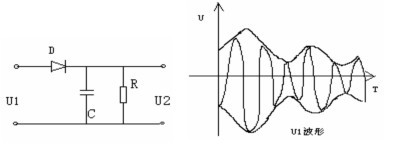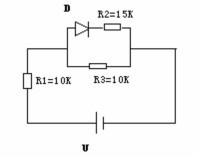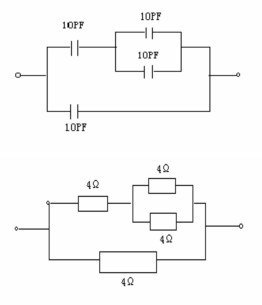6.2 筆試真題 & 詳解
一、 填空
1. 二極管有 1 個PN結,三極管有 2 個PN結。
2 流過電感元件兩端的 電流 發生變化時,會在電感元件兩端產生感應電壓。
3 基本放大電路根據其信號輸入輸出的接法不同,有共射組態、 共集組態度 、共基組態 三種組態之分,這三種組態是最基本的放大單元電路。
4 描述正弦交流信號U(s)=Asin(ωt+φ)的三種物理量A、ω、φ含義分別是 、 、
5 正弦波震蕩電路是由放大電路和 選頻 網絡組成的。
6 二進制數11010用十進制數表示為 26 ;十進制數18用二進制數表示為 10010
二進制數1101+1001= 10110 (用二進制數表示)
7 電容的國際單位為 法拉力(中/英文), 3.3×104PF= UF= F
8 理想化集成運算放大器的兩個特性是 、 ,該特性也是分析理想化運放電路 的基本原則。
9 三極管從放大機理上來說是放大信號的 (電流/電壓?)
10. 三極管的三種工作狀態為 、 、 .
二、 問答1.請簡述調制的作用及方式,與調制相對應的方式是什么?
2 .請畫出二極管、三極管(PNP、NPN型各一個)、晶閘管的電路符號圖。分別說明各自的 用途有哪些?
3.分析說明下面的二極管檢波電路的檢波原理,說出二極管、電容、電阻的各自作用,畫出U2的大致波形。

1、 如下圖之電路,求電流I1和I2的大小(提示:根據基爾霍夫電流定律)要求:寫出基爾霍夫 求職勝經/簡歷 亮出你的精彩簡歷寫作技巧,...面試前準備才是...電流定律的基本內容. A 
2、下圖中二極管為理想二極管(不考慮導通壓降與內阻),計算,當電源電壓分別為+10V和-10V時流過R1的電流是多少?

3.請計算下列的等值阻值或電容值.

1、I go to school on foot everyday.
2、I am looking for work,so I must study try my best everyday.
創維營銷筆試題它涉及的內容沒有營銷專業方面的題目,而是其他的。它的題型是:語言能力測試,數學題,邏輯思維題,計算機。具體的還是需要自己查看,總的來說不算難,差不多都是基礎題。
面試創維數字真題一、請填寫bool , float, 指針變量 與“零值”比較的 if 語句。(10分)
請寫出 bool flag 與“零值”比較的 if 語句。
if ( flag )
if ( !flag )
請寫出 float x 與“零值”比較的 if 語句。
const float epsinon = 0.00001;
if ((x >= - epsinon) & (x <= epsinon)
不可將浮點變量用“”或“!=”與數字比較,應該設法轉化成“>=”或“<=”此類形式。
請寫出 char *p 與“零值”比較的 if 語句。
if (p null)
if (p != null)
二、以下為windows nt下的32位c++程序,請計算sizeof的值(10分)
char str[] = “hello” ;
char *p = str ;
int n = 10;
請計算
sizeof (str ) = 6 (2分)
sizeof ( p ) = 4 (2分)
sizeof ( n ) = 4
void func ( char str[100])
{
請計算
sizeof( str ) = 4 (2分)
}
void *p = malloc( 100 );
請計算
sizeof ( p ) = 4 (2分)
三、簡答題(25分)
1、頭文件中的 ifndef/define/endif 干什么用?(5分)
答:防止該頭文件被重復引用。
2、#include <filename.h> 和 #include “filename.h” 有什么區別?(5分)
答:對于#include <filename.h> ,編譯器從標準庫路徑開始搜索 filename.h
對于#include “filename.h” ,編譯器從用戶的工作路徑開始搜索 filename.h
3、const 有什么用途?(請至少說明兩種)(5分)
答:(1)可以定義 const 常量
(2)const可以修飾函數的參數、返回值,甚至函數的定義體。被const修飾的東西都受到強制保護,可以預防意外的變動,能提高程序的健壯性。
4、在c++ 程序中調用被 c編譯器編譯后的函數,為什么要加 extern “c”? (5分)
答:c++語言支持函數重載,c語言不支持函數重載。函數被c++編譯后在庫中的名字與c語言的不同。假設某個函數的原型為: void foo(int x, int y);
該函數被c編譯器編譯后在庫中的名字為_foo,而c++編譯器則會產生像_foo_int_int之類的名字。
c++提供了c連接交換指定符號extern“c”來解決名字匹配問題。
四、有關內存的思考題(每小題5分,共20分)
一.
void getmemory(char *p)
{
p = (char *)malloc(100);
}
void test(void)
{
char *str = null;
getmemory(str);
strcpy(str, "hello world");
printf(str);
}
請問運行test函數會有什么樣的結果?
答:試題傳入getmemory( char *p )函數的形參為字符串指針,在函數內部修改形參并不能真正的改變傳入形參的值,執行完 char *str = null; getmemory( str ); 后的str仍然為null;
二.
char *getmemory(void)
{
char p[] = "hello world";
return p;
}
void test(void)
{
char *str = null;
str = getmemory();
printf(str);
}
請問運行test函數會有什么樣的結果?
答:可能是亂碼。 char p[] = "hello world"; return p;的p[]數組為函數內的局部自動變量,在函數返回后,內存已經被釋放。這是許多程序員常犯的錯誤,其根源在于不理解變量的生存期。
三.
void getmemory2(char **p, int num)
{
p = (char *)malloc(num);
}
void test(void)
{
char *str = null;
getmemory(str, 100);
strcpy(str, "hello");
printf(str);
}
請問運行test函數會有什么樣的結果?
答: (1)能夠輸出hello (2 )test函數中也未對malloc的內存進行釋放。(3)getmemory避免了試題1的問題,傳入getmemory的參數為字符串指針的指針,但是在getmemory中執行申請內存及賦值語句
p = (char *) malloc( num );
后未判斷內存是否申請成功,應加上: if ( *p null ) {
...//進行申請內存失敗處理
}
四.
void test(void)
{
char *str = (char *) malloc(100);
strcpy(str, “hello”);
free(str);
if(str != null)
{
strcpy(str, “world”);
printf(str);
}
}
請問運行test函數會有什么樣的結果?
答:執行 char *str = (char *) malloc(100); 后未進行內存是否申請成功的判斷;另外,在free(str)后未置str為空,導致可能變成一個“野”指針,應加上: str = null;
五、編寫strcpy函數(10分)
已知strcpy函數的原型是
char *strcpy(char *strdest, const char *strsrc);
其中strdest是目的字符串,strsrc是源字符串。
(1)不調用c++/c的字符串庫函數,請編寫函數 strcpy
char *strcpy(char *strdest, const char *strsrc);
{
assert((strdest!=null) & (strsrc !=null)); // 2分
char *address = strdest; // 2分
while( (*strdest++ = * strsrc++) != ‘\0’ ) // 2分
null ;
return address ; // 2分
}
(2)strcpy能把strsrc的內容復制到strdest,為什么還要char * 類型的返回值?
答:為了實現鏈式表達式。 // 2分
例如 int length = strlen( strcpy( strdest, “hello world”) );
六、編寫類string的構造函數、析構函數和賦值函數(25分)
已知類string的原型為:
class string
{
public:
string(const char *str = null); // 普通構造函數
string(const string other); // 拷貝構造函數
~ string(void); // 析構函數
string operate =(const string &other); // 賦值函數
private:
char *m_data; // 用于保存字符串
};
請編寫string的上述4個函數。
標準答案:
// string的析構函數
string::~string(void) // 3分
{
delete [] m_data;
// 由于m_data是內部數據類型,也可以寫成 delete m_data;
}
// string的普通構造函數
string::string(const char *str) // 6分
{
if(strnull)
{
m_data = new char[1]; // 若能加 null 判斷則更好
*m_data = ‘\0’;
}
else
{
int length = strlen(str);
m_data = new char[length+1]; // 若能加 null 判斷則更好
strcpy(m_data, str);
}
}
// 拷貝構造函數
string::string(const string other) // 3分
{
int length = strlen(other.m_data);
m_data = new char[length+1]; // 若能加 null 判斷則更好
strcpy(m_data, other.m_data);
}
// 賦值函數
string string:perate =(const string other) // 13分
{
// (1) 檢查自賦值 // 4分
if(this other)
return *this;
// (2) 釋放原有的內存資源 // 3分
delete [] m_data;
// (3)分配新的內存資源,并復制內容 // 3分
int length = strlen(other.m_data);
m_data = new char[length+1]; // 若能加 null 判斷則更好
strcpy(m_data, other.m_data);
// (4)返回本對象的引用 // 3分
return *this;
}
